
The lean turnaround of the San Diego Zoo Global
CASE STUDY – Lean thinking is transforming San Diego Zoo Global, helping this century-old organization provide a better experience to its visitors and a better life to its animals.
Words: Jeff Foster, Director of Performance Improvement, San Diego Zoo Global
Gao Gao needs to have his blood pressure checked regularly – a fundamental step in monitoring his heart condition and overall health. Normally this wouldn’t be a problem, if Gao Gao weren’t an elderly giant panda living at our zoo.
The standard procedure most zoos employ to measure blood pressure is to sedate the animal, but we didn’t want to put Gao Gao through that every couple weeks. Therefore, we came together to find a less invasive way for our keepers and veterinarians to carry out the health check. That’s when our team came up with a simple, but extremely effective system: a metal sleeve secured to the squeeze cage, in which Gao Gao inserts his arm while being hand-fed slices of apple (by far his favorite treat).

We go to great lengths to ensure the wellbeing of our animals (they, too, are our customers), and a big part of caring for them – and to run our facility in the smoothest possible way – is to ensure our people feel empowered to own problems and come up with great solutions for them. Indeed, Gao Gao’s blood pressure is just one example of how far the creativity of our associates can go, once unleashed.
When one of our elephants experienced some toe problems, we had to find a way to perform the needed treatment without ever being in actual contact with the animal. (Federal law prevents zookeepers from interacting with an elephant without a barrier of some sort separating them.) The solution was to teach the elephant to stick his leg in an opening of the fence in his enclosure, so that our staff could treat him safely while he enjoyed some lettuce. Our problem solving skills also came in handy when we had to figure out why Mbari, one of our lions, had stopped eating: a thorough analysis of the situation revealed that the poor animal needed a root canal, which we spent a month planning for. It worked, and Mbari quickly regained his standard eating habits.
Lean is really transforming the way our zoo works, providing our 1,200 staff with a better way to work, our five million annual visitors with a better experience, and our 7,000 animals with better care.
THE JOURNEY
We are a 100-year-old organization, running two attraction facilities in Southern California – the San Diego Safari Park and the San Diego Zoo Global. Adopting lean thinking is no easy feat to begin with, but trying to implement it in a century-old business can be even harder.
When I joined the organization six years ago, I met a lot of resistance – something that, I know, happens to most lean practitioners as they start off. People were very reluctant to let me in, and the idea of change was not particularly popular – to keep the animals analogy going, I felt like an unwanted guest in the midst of a crash of rhinos (not very accepting of outsiders).
The old culture was very ingrained in people’s minds, but I wanted to help them to see things differently. To do this, I decided to focus on building trust (without it, lean can never work): I wanted people to know that I wasn’t there to provide the answers, and that I wanted to be with them – the process owners – to understand their pain, and the problems they experienced.
Over time, this approach has paid off, as more and more people are realizing the value of structured process improvement and problem solving.
The first lean experiments we ran – and this was a very conscious choice – focused on things that were sensitive to the CEO. He is not a fan of people waiting, for example, so one of our first projects addressed the long lines at one of our restaurants. We organized a kaizen event there, while beginning to tackle problems in other areas of the zoo – problems that were not necessarily on the radar but that, once solved, would immediately show the C-Suite the power of lean thinking. We may have worked “under the table” when we were trying to shorten the lines at the restaurant or bring standardized work to our African Tram tour, but those early successes were critical in ensuring buy-in from top management – a great boost to our mission.
Before too long, people began to invite me to strategic conversations and to ask for my opinion on other matters. In the meantime, our initial kaizens were getting process owners more and more involved in learning and improving their work – something that continues to gain momentum today. Over time I have taken many of our associates on gemba walks in other organizations, which has greatly increased their understanding of how lean works, and we are now discussing the creation of our own center of excellence – which might open its doors as early as next year.
As lean spreads organically across San Diego Zoo Global, we encounter less and less resistance: each person we manage to bring on board becomes a lean advocate, supporting our mission even when I am not in the room.

LEARNING FOR SUSTAINMENT… AND CONSERVATION
All around the world, human population is encroaching on animal habitats, pushing more and more species on the brink of extinction. This is the force behind the significant shift that many zoos are going through: these facilities still get a bad rap, but in fact many of them focus on conversation work. This means breeding species that are nearly extinct (for instance, if a zoo has a male rhino and another one a female, they will make plans for one of the two to pay the other a visit) and often trying to reintroduce them in the wild.
San Diego Zoo Global is no exception, and every year we transport some 1,500 animals for breeding or reintroduction purposes. Of course, our lean efforts apply to our conversation work, too, and with great results. Our project with the California condor (back in 2004 a critically low number of these birds existed in the wild) is a case in point. We bred this endangered species in our facility and over an endless amount of PDCA cycles we have learned that, if we feed the chicks with a puppet resembling an adult condor rather than by hand, they won’t imprint on humans – which exponentially increases the reintroduction success rate. To date, we have reintroduced 400 California condors into the wild – bringing the species back from “Endangered” to “Vulnerable.”
Experiments, making mistakes and learning from them: these are the main elements lying at the heart of our lean transformation.
The most critical thing to remember is that without learning, improvement is not replicable. We are very much aware of that, especially now that we have started to reuse the learning we gain from our experiments. What we learned when we found a solution to the lion’s root canal problem, for example, inspired us to solve another big problem we were facing – with our elephants’ tusks, whose hollow core gets infected very easily. We realized we could carry out a procedure – a “pulpotomy,” not too different from a root canal – to cut the elephants’ tusks short, clean them and pack them in, thus preventing the problem from reoccurring.
We are striving to create a learning environment at the San Diego Zoo Global, where this sort of exchange can become commonplace. We do it by moving people around the organization horizontally rather than vertically (that’s the direction value travels, by the way): breaking down silos and cross-exposing people to different areas increases their understanding of the big picture and their knowledge. Naturally, this also creates alignment.
However, real alignment also requires effective communication across the organization. Though very challenging, communication is the cornerstone on any lean transformation – together with trust.
What I have learned is that if you want to be a good communicator you need to find the best way to tell the same thing to different people: this means adjusting your message based on who you are talking to. For instance, you would never throw in words like kaizen or hoshin in a room full of animal care staff who have never heard of lean thinking before, would you? The message you want to convey must be adapted to your audience (personally, I have identified eight different types of people I need to talk to – and therefore have eight different ways of saying things).
That our efforts to develop leadership skills in everybody and to become a learning organization are working has become clear now that experiments and projects are being run all around the organization, independently of me. I believe that’s proof that lean is sticking… and considering how tough things were when we began, I couldn’t be prouder of our achievements.
THE AUTHOR

Read more


FEATURE – At Toyota, led by senior executives, suggestion schemes have contributed to decades of improvement. This article explores why they are so effective and encourages you to try one out for yourself.


FEATURE – How do you ensure that visual management doesn’t become anything more than a way to reassure the boss, rather than foster a learning and problem solving culture? The author reflects on her company’s journey towards effective visualization.



FEATURE – Not many people know that digital technology and the IT industry are rife with environmental waste. Discovering it and eliminating early can have beneficial effects on both the business world and the planet.


FEATURE – Following a recent visit to Toyota, the authors strive to challenge popular beliefs and shed a light on the underlying philosophy that has made TPS a success for over half a century.

